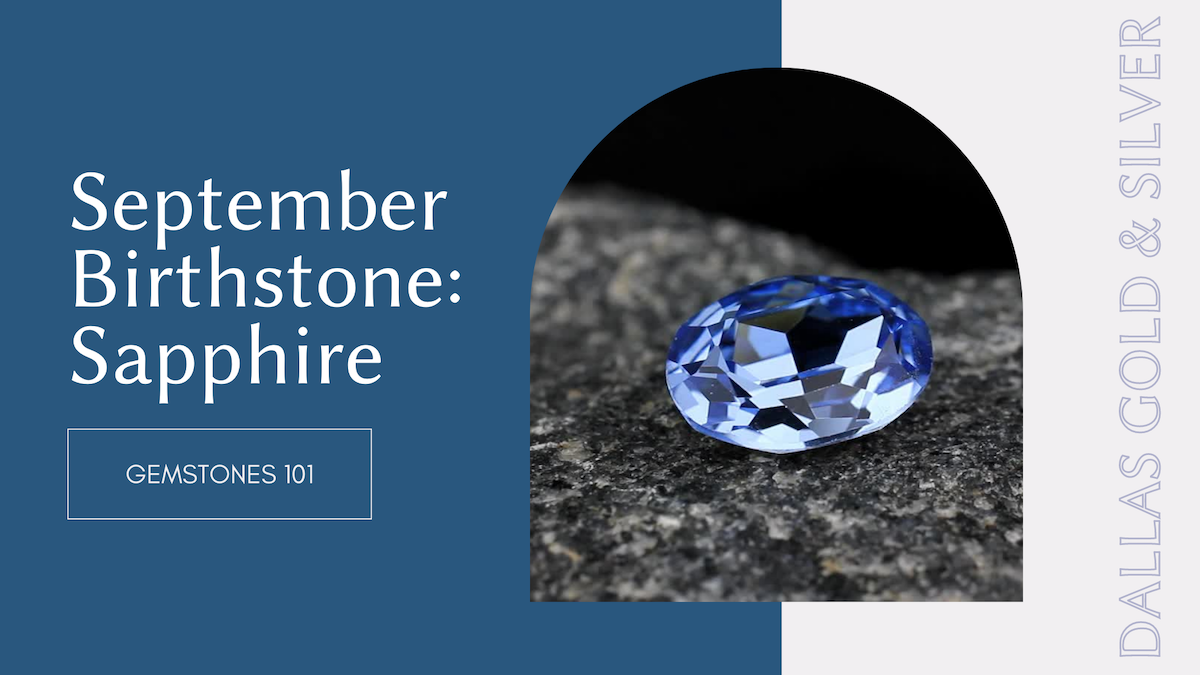Those born in September are lucky enough to call the sapphire their birthstone. Sapphire is also the gemstone for the 5th and 45th anniversaries. This precious gem has a rich history as one of the most coveted jewels among royals and romantics. Let’s dive into what makes sapphire such a unique jewel.
What is the September Birthstone?
The September birthstone is a sapphire.
What is a Sapphire?
A sapphire is a mineral corundum, composed mainly of the trace element aluminum oxide. Falling right below diamonds, it is one of the hardest minerals with a rating of 9 on the Mohs hardness scale. This rating is due to its durability and high resistance to scratching, unlike other precious gems. According to the GIA, “sapphire” can also apply to any corundum that’s not ruby red — those are categorized as rubies. We call any sapphire that’s not blue or red a “fancy” sapphire, which comes in diverse colors. Gemologists typically find blue and fancy sapphires in Madagascar, Tanzania, Sri Lanka, Myanmar, and Australia. Sapphire also has a refractive index of 1.76-1.77, providing more brilliance and sparkle when light bends through it (compared to other gems).
What Colors Do Sapphires Come In?
While we typically think of sapphires as blue, fancy sapphires range in every color except ruby red. Common colors include pink, green, orange, and other hues. How do they get to be each color? First, trace elements of iron and titanium turn corundum blue. In contrast, chromium can cause the red shade of ruby or the pink of pink sapphire. Colorless corundum also makes an excellent replacement for diamonds; however, it is a rare phenomenon and difficult to find. As if you didn’t already have enough options for sapphires, they also come in color-changing varieties. The stones change color under different lighting!
Sapphire Color and Cut Variations
Blue sapphires are the most common and have been an increasingly popular engagement gemstone since 2019.
Padparadascha sapphires: In ancient Sanskrit, this word described the color of a tropical lotus flower. These gems display a mix of pink and orange hues and are considered one of the rarest sapphires in the world.
Pink sapphires were considered extremely rare until the late 1990s, when gemologists found deposits in Madagascar.
White sapphires are transparent and one of the rarest types of sapphires. They gained popularity as a more affordable engagement ring alternative to natural diamonds.
Yellow sapphires are not as costly due to their wide availability. They are more valuable when not treated with heat, as they have a distinct “feather” appearance internally.
Green sapphires are an uncommon color, but they are known to display superior brilliance to emeralds and are more durable than peridots.
Star sapphires include an optical reflection known as asterism, which gives them a mystical appeal with a star-like echo on their surface.
Cabochon sapphires are cut without any light-reflecting features to distract the owner. These stones highlight the sapphire’s unique color in its purest form.
Bi-color sapphires display two distinct colors visible to the naked eye.
Color-changing sapphires are rare — their color shifts when viewed under fluorescent or incandescent lighting.
History of The Sapphire
Historically, sapphires have gained relevance for various uses, including jewelry, optical interfaces, semiconductors, armor, medical devices, and unique tools. Their physical properties of hardness, durability, and clarity make them useful for many purposes. They also used sapphires in decorative objects such as vases, urns, figurines, and mosaics in churches and cathedrals.
Citizens of Ancient Greece and Rome used sapphire to attract wealth and to protect their owners from envy and harm. Long ago, the Persians thought the sky was blue because it reflected a giant sapphire balanced on the Earth. The ancient Babylonians used sapphire to make astronomical tablets, which they used to predict eclipses and other significant celestial events. During the Middle Ages, you would often find clergy wearing sapphires to represent heaven, presumed to attract heavenly blessings. Utilized in many religious ceremonies, the belief was that sapphire had divine powers. Previously, they suspected sapphire possessed medicinal properties, effectively treating ailments like eye infections and even reducing fever. Later in the 20th century, we used sapphire to construct aircraft windows and various industrial applications such as watch crystals, high-precision bearings, and semiconductors.
Fun Facts
Over time, sapphires have become a popular engagement ring choice. Princess Diana’s famous 12-carat sapphire engagement ring is still worn today by Kate Middleton, Prince William’s wife and the Duchess of Cambridge.

Want to learn more? Below are more interesting facts about the infamous, coveted sapphire:
- Sapphire is the typical gem for the 5th and 45th wedding anniversaries.
- The Blue Bell of Asia, the most expensive blue sapphire, was sold for over $17 million in 2014.
- The Rockefeller Sapphire weighs a whopping 62.02 carats and was sold at auction for upwards of $3 million in 2001.
- Astrologically, sapphires are associated with the signs Virgo and Libra.
- Legend says that Helen of Troy possessed a large star sapphire.
- Sailors believed that sapphires would protect them from the perils of sea and prevent them from drowning.
- During the Medieval era, sapphires were thought to change color if worn by someone unfaithful and were used to test a partner’s infidelity.
- King Solomon’s seal was legendary because it was inscribed with sapphire, which was thought to give him power over spirits of the air, earth and the underworld.

